Expert tips for statue repair
Sculptures are not just pieces of art. They are covenants of time, reflections of history and culture. However, accidents do happen, and statues can be damaged. Whether it's a crack or a missing limb, damage can be heartbreaking for art enthusiasts.
But do not despair! With the right tools, techniques and expertise, statue repair is possible. In this blog post, we share expert tips on how to repair a statue like a pro. From understanding your sculpture's materials to identifying damage and planning step-by-step repairs, we've got you covered.
We'll also discuss common issues with statues and how to fix them so you can enjoy your precious artwork again. So grab your tools and let's start recreating beautiful sculptures!
The art and science of statue repair
The art and science of sculpture repair involves a fascinating and complex process. Restoring a sculpture requires a delicate touch and careful attention to detail to ensure the beauty of the artwork is preserved. Scientific techniques are used to repair damaged sculptures, including exploring the use of materials and tools that can effectively repair cracks and fill gaps..
Preserving the integrity of the artwork, as well as its history and cultural significance, is key. The skills required for sculpture repair include a wide range of expertise, from understanding the sculpture's materials to evaluating and planning the repair process. By gaining insights into the art and science of sculpture repair, we can ensure that these magnificent works of art continue to fascinate and inspire generations to come..
Understanding the material of your sculpture
Identifying the material of your sculpture is essential to ensure an accurate restoration. Different materials require special repair techniques and materials. For example, metal sculptures present unique challenges due to their susceptibility to corrosion and oxidation. It is also important to understand the restoration properties of bronze sculptures. Bronze is a popular material for sculptures, but it requires proper cleaning, patination and protection to maintain its beauty.
Soft stone surfaces such as marble or limestone require delicate handling to prevent damage to the edges of the stone. The soluble adhesive in pottery requires specialized techniques to restore, often involving punched holes and punched surfaces to reattach broken pieces.. By understanding the material of your sculpture, you can use the appropriate restoration techniques to maintain its integrity and aesthetic appeal.
Essential tools needed to repair statues
Discover the essential tools needed for a successful sculpture restoration. When it comes to repairing sculptures, having the right tools is very important. Ensure your safety by following proper handling and use procedures and wearing protective clothing. Various types of drilling equipment are used in remediation services that allow precise and accurate hole placement.
Techniques such as precise alignment transfer and paper marking help achieve accuracy in restoring the original shape of the sculpture. It's important to have tools that allow you to drill holes and work around the edges of the stone, ensuring a seamless repair process..
These tools allow you to work on specific parts of the sculpture without causing further damage. By using the right tools and techniques, you can achieve a precise and beautiful restoration.
Safety measures when using repair tools
When working on sculpture repair, it is very important to prioritize safety measures when working with repair tools. To ensure the well-being of both the restorer and the artwork, it is essential to learn and observe the necessary precautions. When working with copper, china and porcelain artwork, be aware of their delicate nature and handle them with care to avoid damage.. It is important to understand the risks associated with epoxy, resin, and wax sculptor restorations.
These materials can contain harmful fumes or require special handling techniques. In addition, when drilling stone surfaces, proper safety guidelines must be followed to prevent injury. Finally, the use of gypsum fillers during sculpture repair requires precautions to ensure safe use and avoid any side effects..
By following these safety measures, you can ensure a safe and successful statue repair process.
Initial assessment – Damage identification and repair planning
When repairing broken pieces of artwork, it's important to start with an initial assessment to identify the extent of the damage. This step is essential for the detailed planning of the restoration process. Patina artworks require specific techniques to identify their restoration needs, while Shona pottery follows a different set of restoration services.. In addition, the broken edges of the stone sculptures must be carefully restored.
During the evaluation, it is important to examine the damaged part of the sculpture and determine the best approach for repair. This may include drilling holes in damaged areas or drilling surfaces for alignment and relocation. By conducting a thorough initial assessment, an effective restoration plan for the damaged artwork can be ensured.
Step-by-step guide to repair broken parts of the statue
Learn the steps of cleaning and preparing the statue step by step. Start by carefully examining the broken parts and assessing the extent of the damage. Clean the surface of the sculpture using a brush or soft cloth to remove any dirt or debris. If there is loose paint or varnish, gently scrape it off using a palette knife.
Next, use a mild detergent solution to clean the sculpture, making sure to avoid harsh chemicals that can further damage the artwork..
Moving on to the actual repair process, start by repairing the cracks of the bronze statue restoration. Apply a small amount of epoxy glue on the crack and gently press the broken pieces together.
Hold them in place until the glue sets. To fill the gaps in the restoration of soft stone surfaces, use suitable fillers that match the color and texture of the sculpture.. Apply filler to the gap and smooth it out using a palette knife. Allow to dry completely before sanding and polishing the repair area.
To ensure accurate alignment when repairing broken pieces, drill small holes near the edges of the stone where the pieces join.. Make holes in the corresponding places on the broken pieces. Then insert dowels or metal wire into the drilled holes and align them with the holes on the broken parts.. This helps achieve accurate alignment during the reattachment process.
Finally, to repair the broken pieces with soluble adhesive artwork, carefully apply the appropriate adhesive to the broken edges. Press the pieces firmly and hold them in place until the glue hardens. Be careful not to apply too much pressure, as this may cause further damage to the artwork. Once the glue is completely dry, carefully inspect the repaired area and make any necessary touch-ups to ensure a seamless repair..
Cleaning and preparing the statue for repair
To ensure a successful statue repair, it is very important to begin the cleaning and preparation process. Cleaning the surfaces of stone sculptures requires proper techniques to remove dirt, stains, and debris without causing damage.. Similarly, Chinese artwork restoration emphasizes the importance of surface preparation to ensure a smooth repair process.
When it comes to restoring copper sculptures, wax removal is a critical step to expose the underlying surface for effective repairs.. To accurately transfer the level location in the repair of the sculpture, plaster filler removal techniques play a significant role. In addition, restoration of Shona pottery requires special cleaning methods to preserve the integrity of the artwork.
By following these steps and techniques, you can ensure that your sculpture is properly cleaned and prepared for the repair process..
Techniques for repairing cracks and filling gaps
Discover effective techniques for repairing cracks in metal sculptures and techniques used to fill cracks in bronze sculpture restorations.. When it comes to restoring soft stone surfaces, there are certain techniques that can be used. Furthermore, understanding the process of filling the broken edges of stone sculptures is crucial for successful restoration.
Finally, gaining insight into the restoration of broken pieces of soluble adhesive artwork is important for the preservation and restoration of these delicate pieces. By using these techniques and understanding the intricacies of statue repair, you can ensure that your repairs are seamless and long-lasting. Remember to carefully assess the damage before starting any repair process to ensure an accurate repair.
How to ensure repair after perfect color matching?
Achieving seamless color restoration in sculpture repair requires an understanding of color matching techniques. Patina restoration plays an important role in achieving the exact color combination. Explore methods and gain insights into restoring patina artwork for a perfect color match.
Tips for maintenance after repairing the statue
Preserving the beauty of a restored sculpture requires careful attention and proper maintenance techniques. After the statue is repaired, it is important to follow some tips to ensure its longevity and prevent further damage. For metal sculptures, maintenance maintenance involves regular cleaning to remove any dirt or debris that may have accumulated on the surface.. Additionally, protecting the metal by applying a protective coating can help prevent oxidation and corrosion.
When it comes to waxwork restoration, maintenance is very important to keep the sculpture in pristine condition. Dusting the statue regularly and using a thin layer of wax can help preserve its shine and protect it from environmental factors.. For smooth stone surfaces, it is important to avoid abrasive cleaners or harsh chemicals that can damage the sculpture..
Instead, gently cleaning the surface with a soft cloth and mild soap can help maintain its integrity.
Restoration of Shona pottery also requires special maintenance techniques. It is important to avoid exposing pottery to extreme temperatures or humidity, as this can cause it to crack or warp..
Regularly inspecting pottery for any signs of damage and addressing them promptly can help prevent further deterioration. By following these tips for post-repair maintenance, you can ensure that your restored sculpture will be beautiful and well-preserved for years to come..
What are some challenges in repairing the statue?
Repairing statues often comes with challenges. For soft stone surfaces, accurate alignment transfer can be achieved using soluble adhesive. Drilling holes in stone sculptures requires care to avoid damaging the artwork.
Restoring broken parts of porcelain statues may involve filling and epoxy, while bronze statues may require patina restoration services.. Fixing metal sculptures may require soldering copper or bronze pieces together.
What you need to know about statue repair
Sculpture restoration services are essential to preserve valuable works of art and prevent further damage. Knowing the exact location of the holes is critical when it comes to accurate alignment transfers during repairs. In the case of soft stone surfaces, holes may be required to punch paper marking the restoration site. Correct restoration of broken pieces of Chinese sculptures is important to preserve their value.
It is very important to use the right filler, glue and resin to repair the sculpture. Additionally, understanding the rock edges and drilling surface can help ensure a successful restoration process. By following these tips and using the right techniques, you can effectively repair and maintain your precious sculptures.
Common statue problems and how to fix them
Cracks in plaster sculptures can be repaired using fillers and plaster restoration techniques. For broken wax figures, it is recommended to seek the expertise of a professional sculptor who can restore them to their former glory.. When it comes to Shona clay figurines, you may need to drill holes to accurately move and align the broken pieces..
Broken porcelain figurines can be repaired using epoxy and filler to carefully repair the broken pieces.. Similarly, repairing broken copper artwork often involves the process of soldering individual pieces together. These are some of the common problems encountered in sculptures, but with the right techniques and tools, they can be effectively repaired and restored to their original beauty..
Step by step guide Statue repair
To begin the sculpture repair process, the first step is to thoroughly clean the surface. This ensures that there are no dirt or debris particles that could hinder the repair. Then use epoxy or filler to glue the broken pieces of the sculpture together. This requires precision and precise application to ensure that the parts are perfectly aligned. After the glue dries, it is important to smooth the repaired surfaces using sandpaper.
This will help create a seamless finish and eliminate any jagged edges. For bronze sculptures, it is important to use the appropriate patina restoration to achieve a uniform appearance. Finally, accurate alignment of the drilled holes is essential when repairing stone sculptures. This ensures that the reconstructed part of the statue fits perfectly and maintains its integrity.
By following these step-by-step instructions, you can effectively restore the statue to its original glory.
Frequently Asked Questions
What are the most common types of damage to statues?
Some of the most common types of damage sculptures can experience include cracks, chips, and weathering.. Cracks can be caused by factors such as age, movement or exposure to extreme temperatures. Chips can be caused by accidental impact or deliberate vandalism. Weathering can result in discoloration, erosion, or loss of detail over time.
What are some techniques for repairing small cracks or chips in sculpture repair?
Use epoxy fillers to repair small cracks or chips in the sculpture. For better adhesion, clean the area thoroughly before applying the filler. After drying, sand the repaired area to blend with the surrounding surface. Finally, paint or finish the repaired area to match the rest of the statue.
How can I prevent further damage to the statue after it is repaired?
To prevent further damage to the repaired sculpture, keep it away from direct sunlight, moisture and extreme temperatures. Apply a protective coating or sealant to protect it from the elements. Avoid placing heavy objects in your vicinity that may cause cracks or breaks. Check regularly for wear and tear and fix them promptly.
Result
Repairing the sculpture requires a delicate touch and careful examination of the materials and techniques used. Understanding the art and science behind statue repair is essential to ensure that the restoration is done efficiently and accurately. By following a step-by-step guide and using the necessary tools, you can repair cracks, fill cracks, and restore the sculpture to its former glory..
Additionally, attention to color matching and post-repair maintenance is critical to ensure a seamless repair. While statue repair can present challenges, with the right knowledge and expertise, you can overcome them and enjoy a beautifully restored statue for years to come..

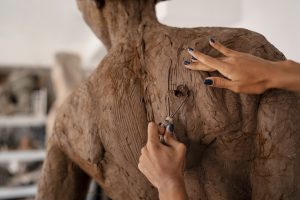
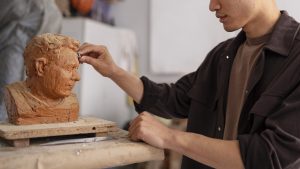
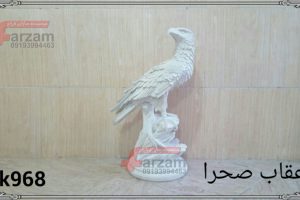 Desert Eagle polyester sculptures of animals
Desert Eagle polyester sculptures of animals Fiberglass shelf edge angel figurines
Fiberglass shelf edge angel figurines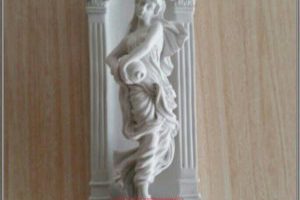 Polyester statue of the Virgin Mary
Polyester statue of the Virgin Mary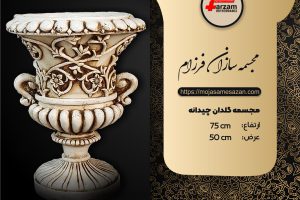 Stackable vase statue
Stackable vase statue